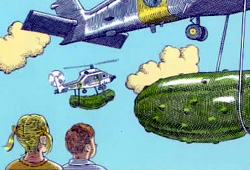
The best children’s books can be enjoyed by anyone. They not only entertained and thrilled us as kids, but bring back nostalgic memories in adulthood. From The Cat in Hat of Dr. Seuss, to Where the Wild Things Are by Maurice Sendak, to The Little Prince of Antoine de Saint-Exupéry, the illustrated tomes of youth are filled with adventures and mystery, humor and suspense, with images that have become part of our collective cultural experiences.
In 1978, Judi Barrett added yet another entry to the list of memorable children’s stories with Cloudy with a Chance of Meatballs, a tale that chronicles the experiences of two youngsters in the imaginary land of Chewandswallow. The book has been cited on many “Top 100” lists in the years since its initial release, and was even transformed onto the big screen with a 2009 animated film adaptation.
“I think of a sentence,” Judi Barrett explained to Celebrity Parents of her writing process. “For Cloudy, the sentence was, ‘Henry walked outside and got hit in the head with a meatball.’ That is literally how it started. It was a crazy, crazy sentence. From that, this book came. It grew.”
Twenty-two years after Cloudy with a Chance of Meatballs was published by Simon & Shuster, Barrett released a sequel in which the main characters of the original once again visit Chewandswallow. While meatballs were the inspiration in 1978, apparently pickles played a role in 2000, as well as the Steel City. Pickles to Pittsburgh may not be as well-known as Cloudy with a Chance of Meatballs, but is an effective children’s story nonetheless and has forever connected Pittsburgh to the imaginary world of Chewandswallow.
“Across an ocean, over lots of huge bumpy mountains, across three hot deserts, and one smaller ocean,” Grandpa tells the children at the beginning of Cloudy with a Chance of Meatballs. “There lay the tiny town of Chewandswallow.”
Chewandswallow is just like any other small town, with a Main Street, houses with outdoor gardens, 300 residents and an assortment of dogs and cats. One thing missing, however, are grocery stores, as they are simply no longer needed. It turns out that the weather of Chewandswallow is filled with food and beverages, and it “rains” everything from juice and milk to hot dogs and hamburgers throughout the day.
As the story progresses, however, the weather grows worse. The Sanitation Department is unable to remove all the excess food, a large pancake falls on the school, and giant meatballs have destroyed many of the homes. Left with no choice, the residents of Chewandswallow construct makeshift rafts out of stale peanut butter sandwiches and set sail for a new place to call home.
In the opening pages of Pickles to Pittsburgh, the same children receive a postcard from their vacationing Grandpa. With her head filled with thoughts of all the strange places he has visited, the young girl narrator falls asleep and dreams of Chewandswallow. The land is still overrun with food, only now the former residents have returned to not only reclaim their town but ship the excess food to cities and countries around the world.
Pitchforks lift giant baked potatoes, helicopters carry tuna fish sandwiches, and ships are loaded with hot dogs still in their buns and covered with mustard. “Eggplants to Ecuador” and “Milk to Milwaukee” the Shipping Schedule for Monday reads, while the first listing under Tuesday states, “Pickles to Pittsburgh.” The Falling Food Company created by the former residents of Chewandswallow is able to literally feed the world with the food provided by the weather.
Although alliteration appears to be the main reason that Pittsburgh has been slated to receive pickles from Chewandswallow, it is an ironic choice nonetheless. In the late nineteenth century, H.J. Heinz founded the company that still bears his name and began selling food produce and condiments from Pittsburgh. Although the H.J. Heinz Company has been synonymous with ketchup for well over a century, pickles were a major component of the company’s initial success and run a close second in terms of the food manufacture’s history and legacy.
In July 2015, meanwhile, the first Picklesburgh food festival was held in the Steel City. “Americans consume twenty-six billion pickles per year, or nine pounds per person,” Allegheny County Executive Rich Fitzgerald told WESA at the time. “Pickles are mentioned as far back as in the Bible, and also can be found in the works of Shakespeare. Obviously, our pickle roots go back to our ethnic population as well as the commercial production dating back to the nineteenth century.”
Pittsburgh may be known for many things – including its steel mills, bridges, and professional sports teams – but pickles helped shape the region as much as anything else. Thanks to the good folks of Chewandswallow and the steady supply of giant pickles being shipped to the city via helicopter, Pittsburgh will no doubt continue to be the Pickle Capital of the World for many more years to come.
Anthony Letizia

